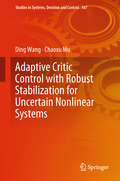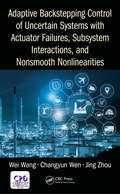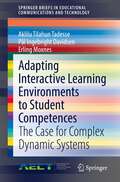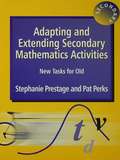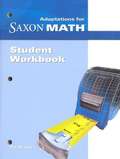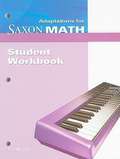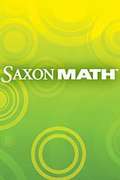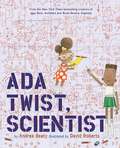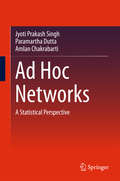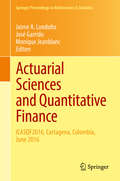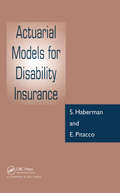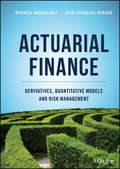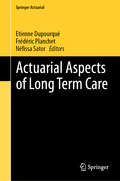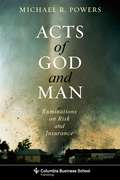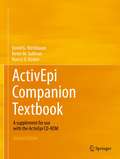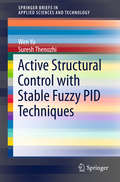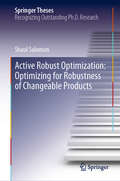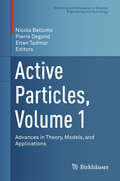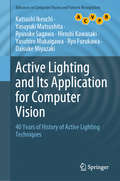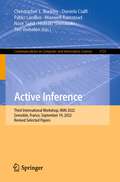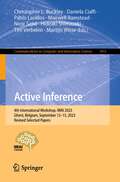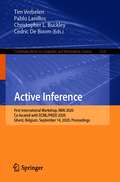- Table View
- List View
Adaptive Critic Control with Robust Stabilization for Uncertain Nonlinear Systems (Studies in Systems, Decision and Control #167)
by Ding Wang Chaoxu MuThis book reports on the latest advances in adaptive critic control with robust stabilization for uncertain nonlinear systems. Covering the core theory, novel methods, and a number of typical industrial applications related to the robust adaptive critic control field, it develops a comprehensive framework of robust adaptive strategies, including theoretical analysis, algorithm design, simulation verification, and experimental results. As such, it is of interest to university researchers, graduate students, and engineers in the fields of automation, computer science, and electrical engineering wishing to learn about the fundamental principles, methods, algorithms, and applications in the field of robust adaptive critic control. In addition, it promotes the development of robust adaptive critic control approaches, and the construction of higher-level intelligent systems.
Adaptive Backstepping Control of Uncertain Systems with Actuator Failures, Subsystem Interactions, and Nonsmooth Nonlinearities
by Wei Wang Changyun Wen Jing ZhouIn practice, actuators often undergo failures and various factors influence its effectiveness. Also due to the increasing complexity of large-scale systems, subsystems are often interconnected, whereas the interactions between any two subsystems are difficult to deal with. This book details a series of new methodologies of designing and analyzing adaptive backstepping control systems involving treatment on actuator failures, subsystem interactions and nonsmooth nonlinearities. Moreover, it discusses some interesting open issues in adaptive failure accommodation, decentralized adaptive control and distributed adaptive coordinated control.
Adapting Interactive Learning Environments to Student Competences: The Case for Complex Dynamic Systems (SpringerBriefs in Educational Communications and Technology)
by Aklilu Tilahun Tadesse Pål Ingebright Davidsen Erling MoxnesThis monograph focuses on the design of personalized and adaptive online interactive learning environment (OILE) to enhance students’ learning in and about complex dynamic systems (CDS). Numerous studies show that students experience difficulties when learning in and about CDS. The difficulties are due to challenges originating from a) the structural complexity of CDS, (b) the production of dynamic behavior from the underlying systems structure, and (c) methods, techniques and tools employed in the analysis of such systems. Despite the fact that studies have uncovered such learning challenges, it is still not well understood how we may effectively address these challenges. In this monograph, the authors provide some answers as to how we may best improve our cognitive capabilities to meet these challenges by way of effective instructional methods, techniques, and tools and their implementation in the form of an OILE. The OILE developed for this purpose, builds on a five-step holistic instructional design framework; identification of instructional design models, identification of authentic learning material, identification of instructional methods, identification of instructional techniques, and design of the interface and implementation of the tool. In this OILE development, six well-documented instructional design models were considered; a four component instructional design, first principles of instruction, constructivists learning environment, task centered instruction, cognitive apprenticeship, and elaboration theory.
Adapting and Extending Secondary Mathematics Activities: New Tasks FOr Old
by Pat Perks Stephanie PrestageThis book is designed to assist teachers to get the most out of the textbooks or mathematics schemes used in their schools, providing methods of extending the activities offered to learners.
Adaptations for Saxon Math Student Reference Guide Intermediate 3-5
by Pat WrigleyNIMAC-sourced textbook
Ada Twist, Scientist
by Andrea Beaty David RobertsLike her classmates, builder Iggy and inventor Rosie, scientist Ada, a character of color, has a boundless imagination and has always been hopelessly curious. Why are there pointy things stuck to a rose? Why are there hairs growing inside your nose? When her house fills with a horrific, toe-curling smell, Ada knows it’s up to her to find the source. What would you do with a problem like this? Not afraid of failure, Ada embarks on a fact-finding mission and conducts scientific experiments, all in the name of discovery. But, this time, her experiments lead to even more stink and get her into trouble! Inspired by real-life makers such as Ada Lovelace and Marie Curie, Ada Twist, Scientist champions girl power and women scientists, and brings welcome diversity to picture books about girls in science. Touching on themes of never giving up and problem solving, Ada comes to learn that her questions might not always lead to answers, but rather to more questions. She may never find the source of the stink, but with a supportive family and the space to figure it out, she’ll be able to feed her curiosity in the ways a young scientist should.
Ad Hoc Networks: A Statistical Perspective
by Paramartha Dutta Amlan Chakrabarti Jyoti Prakash SinghThis book identifies the time-dependent network parameters: neighbour count, link load, path length, cluster count and delay, and presents a first-of-its-kind discussion on temporal parameters in mobile ad hoc networks. Frequent topology changes and multiple link failures occur in mobile ad hoc network due to arbitrary and random movement of nodes. <P><P>This dynamic environment challenges the delivery of data and makes it essential to find better models for network parameters that are shifting with time. The parameters identified are put into the framework of time series because of their temporal characteristic, and when they are modelled using time series framework they exhibit a sound fit with Autoregressive AR(p) models of order p. <P>The order p is evaluated for each fitted model and found to lie between one and three. The book also analyses the dependence of end-to-end delay of ad hoc network on various external factors such as the number of nodes, routing protocol, mobility models and path length and develops two prediction models. The book will be useful for researchers and professionals alike.
Actuarial Sciences and Quantitative Finance: ICASQF2016, Cartagena, Colombia, June 2016 (Springer Proceedings in Mathematics & Statistics #214)
by Jaime A. Londoño José Garrido Monique JeanblancDeveloped from the Second International Congress on Actuarial Science and Quantitative Finance, this volume showcases the latest progress in all theoretical and empirical aspects of actuarial science and quantitative finance. Held at the Universidad de Cartagena in Cartegena, Colombia in June 2016, the conference emphasized relations between industry and academia and provided a platform for practitioners to discuss problems arising from the financial and insurance industries in the Andean and Caribbean regions. Based on invited lectures as well as carefully selected papers, these proceedings address topics such as statistical techniques in finance and actuarial science, portfolio management, risk theory, derivative valuation and economics of insurance.
Actuarial Models for Disability Insurance
by S Haberman E PitaccoDisability insurance, long-term care insurance, and critical illness cover are becoming increasingly important in developed countries as the problems of demographic aging come to the fore. The private sector insurance industry is providing solutions to problems resulting from these pressures and other demands of better educated and more prosperous
Actuarial Finance: Derivatives, Quantitative Models and Risk Management
by Mathieu Boudreault Jean-François RenaudA new textbook offering a comprehensive introduction to models and techniques for the emerging field of actuarial Finance Drs. Boudreault and Renaud answer the need for a clear, application-oriented guide to the growing field of actuarial finance with this volume, which focuses on the mathematical models and techniques used in actuarial finance for the pricing and hedging of actuarial liabilities exposed to financial markets and other contingencies. With roots in modern financial mathematics, actuarial finance presents unique challenges due to the long-term nature of insurance liabilities, the presence of mortality or other contingencies and the structure and regulations of the insurance and pension markets. Motivated, designed and written for and by actuaries, this book puts actuarial applications at the forefront in addition to balancing mathematics and finance at an adequate level to actuarial undergraduates. While the classical theory of financial mathematics is discussed, the authors provide a thorough grounding in such crucial topics as recognizing embedded options in actuarial liabilities, adequately quantifying and pricing liabilities, and using derivatives and other assets to manage actuarial and financial risks. Actuarial applications are emphasized and illustrated with about 300 examples and 200 exercises. The book also comprises end-of-chapter point-form summaries to help the reader review the most important concepts. Additional topics and features include: Compares pricing in insurance and financial markets Discusses event-triggered derivatives such as weather, catastrophe and longevity derivatives and how they can be used for risk management; Introduces equity-linked insurance and annuities (EIAs, VAs), relates them to common derivatives and how to manage mortality for these products Introduces pricing and replication in incomplete markets and analyze the impact of market incompleteness on insurance and risk management; Presents immunization techniques alongside Greeks-based hedging; Covers in detail how to delta-gamma/rho/vega hedge a liability and how to rebalance periodically a hedging portfolio. This text will prove itself a firm foundation for undergraduate courses in financial mathematics or economics, actuarial mathematics or derivative markets. It is also highly applicable to current and future actuaries preparing for the exams or actuary professionals looking for a valuable addition to their reference shelf. As of 2019, the book covers significant parts of the Society of Actuaries’ Exams FM, IFM and QFI Core, and the Casualty Actuarial Society’s Exams 2 and 3F. It is assumed the reader has basic skills in calculus (differentiation and integration of functions), probability (at the level of the Society of Actuaries’ Exam P), interest theory (time value of money) and, ideally, a basic understanding of elementary stochastic processes such as random walks.
Actuarial Aspects of Long Term Care (Springer Actuarial)
by Frédéric Planchet Etienne Dupourqué Néfissa SatorThis book proposes a review of Long-Term Care insurance; this issue is addressed both from a global point of view (through a presentation of the risk of dependence associated with the aging of the population) and an actuarial point of view (with the presentation of existing insurance products and actuarial techniques for pricing and reserving). It proposes a cross-view of American and European experiences for this risk. This book is the first dedicated entirely to long-term care insurance and aims to provide a useful reference for all actuaries facing this issue. It is intended for both professionals and academics.
Acts of God and Man: Ruminations on Risk and Insurance (Columbia Business School Publishing Ser.)
by Michael PowersMuch has been written about the ups and downs of financial markets, from the lure of prosperity to the despair of crises. Yet a more fundamental and pernicious source of uncertainty exists in today's world: the traditional "insurance" risks of earthquakes, storms, terrorist attacks, and other disasters. Insightfully exploring these "acts of God and man," Michael R. Powers guides readers through the methods available for identifying and measuring such risks, financing their consequences, and forecasting their future behavior within the limits of science.A distinctive characteristic of earthquakes, hurricanes, bombings, and other insurance risks is that they impact the values of stocks, bonds, commodities, and other market-based financial products, while remaining largely unaffected by or "aloof" from the behavior of markets. Quantifying such risks given limited data is difficult yet crucial for achieving the financing objectives of insurance. Powers begins with a discussion of how risk impacts our lives, health, and possessions and proceeds to introduce the statistical techniques necessary for analyzing these uncertainties. He then considers the experience of risk from the perspectives of both policyholders and insurance companies, and compares their respective responses.The risks inherent in the private insurance industry lead naturally to a discussion of the government's role as both market regulator and potential "insurer of last resort." Following a thoughtful and balanced analysis of these issues, Powers concludes with an interdisciplinary investigation into the nature of uncertainty, incorporating ideas from physics, philosophy, and game theory to assess science's limitations in predicting the ramifications of risk.
ActivEpi Companion Textbook: A supplement for use with the ActivEpi CD-ROM
by David G. Kleinbaum Kevin M. Sullivan Nancy D. BarkerThis Companion Textbook supplements the ActivEpi CD-ROM, sold separately. The ActivEpi CD-ROM provides a multimedia presentation of concepts, commonly taught in an introductory epidemiology course. ActivEpi mixes a full array of media to motivate, explain, visualize and apply epidemiological concepts. Virtually all of the material on the ActivEpi CD-ROM is included in the Companion Textbook. Because individuals differ in their learning skills, the ActivEpi CD-ROM and the ActivEpi Companion Textbook offer readers different but related options on how to learn epidemiology. The Textbook can be used as a hardcopy reference of the textual materials contained on the CD-ROM, as a resource for the practice exercises, as a general reference, or even a self-contained textbook. ActivEpi includes 15 lessons and over 50 hours of content via more than 250 launchable activities and homework exercises. It can be used in a variety of teaching formats: distance learning, self-paced learning, on-campus courses, and short courses. For the latest additions to ActivEpi, visit David Kleinbaum's website.
Active Structural Control with Stable Fuzzy PID Techniques (SpringerBriefs in Applied Sciences and Technology)
by Wen Yu Suresh ThenozhiThis book presents a detailed discussion of intelligenttechniques to measure the displacement of buildings when they are subjected tovibration. It shows how these techniques are used to control active devicesthat can reduce vibration 60-80% more effectively than widely used passiveanti-seismic systems. After introducing various structural control devices andbuilding-modeling and active structural control methods, the authors proposeoffset cancellation and high-pass filtering techniques to solve some commonproblems of building-displacement measurement using accelerometers. The mostpopular control algorithms in industrial settings, PD/PID controllers, are thenanalyzed and then combined with fuzzy compensation. The stability of thiscombination is proven with standard weight-training algorithms. These conditionsprovide explicit methods for selecting PD/PID controllers. Finally, fuzzy-logicand sliding-mode control are applied to the control of wind-induced vibration. The methods described are supported by reports of experimental studies on atwo-story building prototype. This book is avaluable resource for academic researchers interested in the effects of controland mechatronic devices within buildings, or those studying the principles ofvibration reduction. Practicing engineers working on the design andconstruction of any sort of high-rise or vulnerable building and concerned withthe effects of either wind or seismic disturbances benefit from the efficacy ofthe methods proposed.
Active Robust Optimization: Optimizing for Robustness of Changeable Products (Springer Theses)
by Shaul SalomonThis book presents a novel framework, known as Active Robust Optimization, which provides the tools for evaluating, comparing and optimizing changeable products. Since any product that can change its configuration during normal operation may be considered a “changeable product,” the framework is widely applicable. Further, the methodology enables designers to use adaptability to deal with uncertainties and so avoid over-conservative designs. Offering a comprehensive overview of the framework, including its unique features, such as its ability to optimally respond to uncertain situations, the book also defines a new class of optimization problem and examines the effects of changes in various parameters on their solution. Lastly, it discusses innovative approaches for solving the problem and demonstrates these with two examples from different fields in engineering design: optimization of an optical table and optimization of a gearbox.
Active Particles, Volume 3: Advances in Theory, Models, and Applications (Modeling and Simulation in Science, Engineering and Technology)
by Nicola Bellomo José Antonio Carrillo Eitan TadmorThis edited volume collects six surveys that present state-of-the-art results on modeling, qualitative analysis, and simulation of active matter, focusing on specific applications in the natural sciences. Following the previously published Active Particles volumes, these chapters are written by leading experts in the field and reflect the diversity of subject matter in theory and applications within an interdisciplinary framework. Topics covered include:Variability and heterogeneity in natural swarmsMultiscale aspects of the dynamics of human crowdsMathematical modeling of cell collective motion triggered by self-generated gradientsClustering dynamics on graphsRandom Batch Methods for classical and quantum interacting particle systemsThe consensus-based global optimization algorithm and its recent variantsMathematicians and other members of the scientific community interested in active matter and its many applications will find this volume to be a timely, authoritative, and valuable resource.
Active Particles, Volume 2: Advances in Theory, Models, and Applications (Modeling and Simulation in Science, Engineering and Technology)
by Nicola Bellomo Pierre Degond Eitan TadmorThis volume compiles eight recent surveys that present state-of-the-art results in the field of active matter at different scales, modeled by agent-based, kinetic, and hydrodynamic descriptions. Following the previously published volume, these chapters were written by leading experts in the field and accurately reflect the diversity of subject matter in theory and applications. Several mathematical tools are employed throughout the volume, including analysis of nonlinear PDEs, network theory, mean field approximations, control theory, and flocking analysis. The book also covers a wide range of applications, including:Biological network formationSocial systemsControl theory of sparse systemsDynamics of swarming and flocking systemsStochastic particles and mean field approximationsMathematicians and other members of the scientific community interested in active matter and its many applications will find this volume to be a timely, authoritative, and valuable resource.
Active Particles, Volume 1: Advances in Theory, Models, and Applications (Modeling and Simulation in Science, Engineering and Technology)
by Nicola Bellomo Pierre Degond Eitan TadmorThis volume collects ten surveys on the modeling, simulation, and applications of active particles using methods ranging from mathematical kinetic theory to nonequilibrium statistical mechanics. The contributing authors are leading experts working in this challenging field, and each of their chapters provides a review of the most recent results in their areas and looks ahead to future research directions. The approaches to studying active matter are presented here from many different perspectives, such as individual-based models, evolutionary games, Brownian motion, and continuum theories, as well as various combinations of these. Applications covered include biological network formation and network theory; opinion formation and social systems; control theory of sparse systems; theory and applications of mean field games; population learning; dynamics of flocking systems; vehicular traffic flow; and stochastic particles and mean field approximation. Mathematicians and other members of the scientific community interested in active matter and its many applications will find this volume to be a timely, authoritative, and valuable resource.
Active Lighting and Its Application for Computer Vision: 40 Years of History of Active Lighting Techniques (Advances in Computer Vision and Pattern Recognition)
by Katsushi Ikeuchi Yasuyuki Matsushita Ryusuke Sagawa Hiroshi Kawasaki Yasuhiro Mukaigawa Ryo Furukawa Daisuke MiyazakiThis book describes active illumination techniques in computer vision. We can classify computer vision techniques into two classes: passive and active techniques. Passive techniques observe the scene statically and analyse it as is. Active techniques give the scene some actions and try to facilitate the analysis. In particular, active illumination techniques project specific light, for which the characteristics are known beforehand, to a target scene to enable stable and accurate analysis of the scene. Traditional passive techniques have a fundamental limitation. The external world surrounding us is three-dimensional; the image projected on a retina or an imaging device is two-dimensional. That is, reduction of one dimension has occurred. Active illumination techniques compensate for the dimensional reduction by actively controlling the illumination. The demand for reliable vision sensors is rapidly increasing in many application areas, such as robotics and medical image analysis. This book explains this new endeavour to explore the augmentation of reduced dimensions in computer vision. This book consists of three parts: basic concepts, techniques, and applications. The first part explains the basic concepts for understanding active illumination techniques. In particular, the basic concepts of optics are explained so that researchers and engineers outside the field can understand the later chapters. The second part explains currently available active illumination techniques, covering many techniques developed by the authors. The final part shows how such active illumination techniques can be applied to various domains, describing the issue to be overcome by active illumination techniques and the advantages of using these techniques. This book is primarily aimed at 4th year undergraduate and 1st year graduate students, and will also help engineers from fields beyond computer vision to use active illumination techniques. Additionally, the book is suitable as course material for technical seminars.
Active Inference: Third International Workshop, IWAI 2022, Grenoble, France, September 19, 2022, Revised Selected Papers (Communications in Computer and Information Science #1721)
by Christopher L. Buckley Daniela Cialfi Pablo Lanillos Maxwell Ramstead Noor Sajid Hideaki Shimazaki Tim VerbelenThis volume constitutes the papers of the 3rd International Workshop on Active Inference, IWAI 2022, held in Grenoble, France, in conjunction with ECML/PKDD, on September 19, 2022.The 25 revised full papers presented in this book were carefully reviewed and selected from 31 submissions.
Active Inference: 4th International Workshop, IWAI 2023, Ghent, Belgium, September 13–15, 2023, Revised Selected Papers (Communications in Computer and Information Science #1915)
by Christopher L. Buckley Daniela Cialfi Pablo Lanillos Maxwell Ramstead Noor Sajid Hideaki Shimazaki Tim Verbelen Martijn WisseThis volume constitutes the papers of the 4th International Workshop on Active Inference, IWAI 2023, held in Ghent, Belgium on September 2023.The 17 full papers included in this book were carefully reviewed and selected from 34 submissions. They were organized in topical sections as follows: active inference and robotics; decision-making and control; active inference and psychology; from theory to implementation; learning representations for active inference; and theory of learning and inference.
Active Inference: First International Workshop, IWAI 2020, Co-located with ECML/PKDD 2020, Ghent, Belgium, September 14, 2020, Proceedings (Communications in Computer and Information Science #1326)
by Tim Verbelen Pablo Lanillos Christopher L. Buckley Cedric De BoomThis book constitutes the refereed proceedings of the First International Workshop on Active Inference, IWAI 2020, co-located with ECML/PKDD 2020, held in Ghent, Belgium, in September 2020. The 13 full papers along with 6 short papers were thoroughly reviewed and selected from 25 submissions. They are organized in the topical sections on active inference and continuous control; active inference and machine learning; active inference: theory and biology.
Active Assisted Living: Anwendungsszenarien und Lösungsansätze für ein selbstbestimmtes Leben
by Marcel Sailer Andreas MahrIn dem vorliegenden Open-Access-Buch identifizieren Studierende und Lehrende interprofessionell Entwicklungen und Problemfelder der Assistiven Technologien. Diese halten zunehmend Einzug ins Leben versorgungsbedürftiger, häufig älterer Menschen. Nach einigen Jahren der Entwicklung kann konstatiert werden, dass der Transfer von Entwicklung zur Anwendung im Alltag infolge unterschiedlicher Perspektiven und Zielsetzungen nur unzureichend stattfindet. Die Beitragsautoren bieten kreative Lösungsansätze, die zu einer nachhaltigen Umsetzung führen sollen.Dies ist ein Open-Access-Buch.
